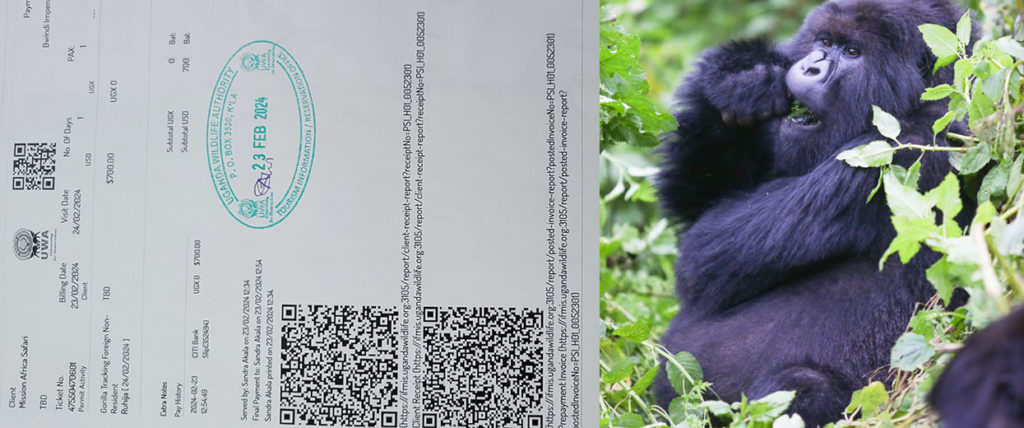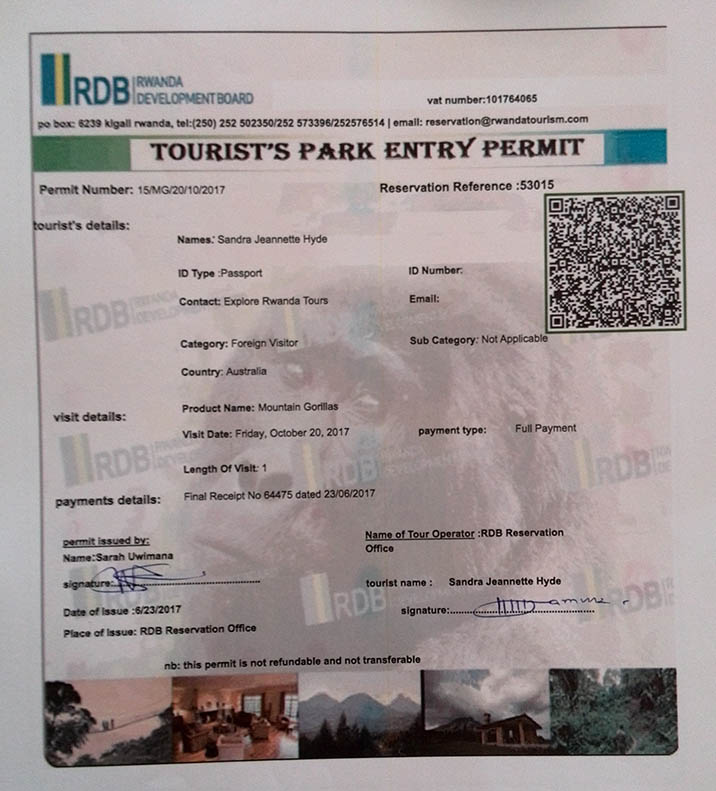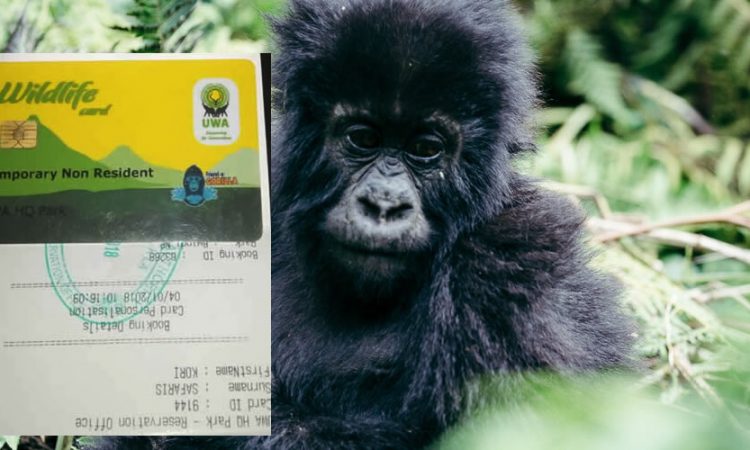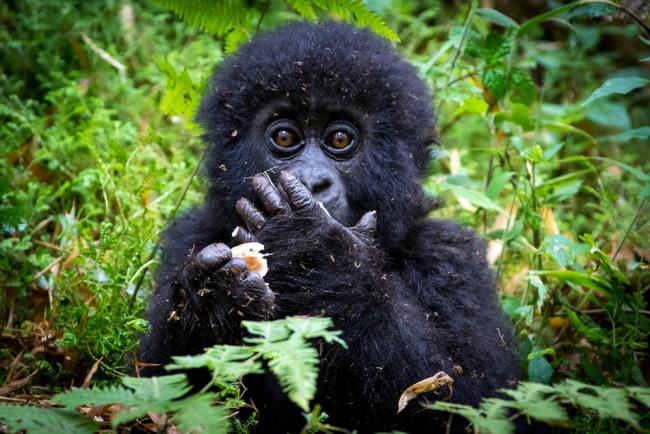Gorilla permits Uganda, Rwanda and Congo
Gorilla permits Uganda, Rwanda and Congo : Because Uganda, Rwanda, and the Congo have the biggest concentration of mountain gorillas in the world, these nations are well-liked travel destinations for ecotourists wishing to get a close-up look at these critically endangered animals / endagered moutain gorilla species . Thousands of tourists travel to Uganda and Rwanda each year to go on gorilla trekking expeditions.
These excursions not only offer a close-up look at these amazing animals, but they also contribute to the funding of mountain gorilla conservation. Every visitor to the mountain gorillas needs to have a permit.

A tour operator or safari company that bought permits from the Uganda Wildlife Authority (UWA) in Uganda and the Rwanda Development Board (RDB) in Rwanda can provide them to you. In Rwanda, a gorilla permit costs $1500, whereas in Uganda it costs $800.
Thus, what is a gorilla permit exactly?
An authorisation card known as a gorilla permit is what gives you access to see mountain gorillas in Rwanda ,Uganda and congo. This is a per-person permit that allows you to spend an hour with a single family of mountain gorillas.
The gorilla permit fees are significant since they restrict the amount of visitors who may enter the parks and support the gorillas’ conservation efforts. The cost remains the same for an hour, regardless of how long you spend seeing the gorillas.
Permits for Gorilla Habituation
The process of acclimating wild gorillas to human presence is known as gorilla habituation. This is necessary for gorilla tourism because it enables visitors to engage safely with these incredible creatures. Gorilla habituation licenses cost more than standard permits because they let visitors interact with the gorillas for four hours as opposed to just one.
You can participate in the additional time needed to gradually acclimate the gorillas to human presence. This procedure is critical to ensuring the safety of both people and gorillas, as well as minimizing the negative effects of gorilla tourism on gorilla populations. In Uganda, gorilla habituation permits cost $1500 and ensure four hours of time spent with the gorillas.
How Much Does a Ugandan Gorilla Permit Cost?
Costs associated with gorilla safaris
$800 per person for each trek (one hour with the gorillas) is the cost of a gorilla permit.
A gorilla habituation permit costs $1500 each excursion, which includes four hours with the primates.
The cost of a three-day gorilla trek, including transportation, lodging, and meals, starts at $1200 per person; however, different tour companies charge differently. You have the option of going to Mount Mgahinga Gorilla National Park or Bwindi Impenetrable Forest National Park.
Rwanda Gorilla Permit Cost
In Rwanda, each individual must pay $1500 for a gorilla permit. If you want to experience a luxurious gorilla trek in Rwanda’s Volcanoes National Park, the country offers both luxurious trekking and lodging alternatives. Opt for Bisate Lodge , Kwitonda Lodge , one and only gorilla nest lodge when you go to see the gorillas in Rwanda.

Congolese Gorilla Identity Document
trekking with gorillas in the Congo
Because a gorilla trek permit in Congo costs $400 per person each trek, it is the least expensive alternative for following gorillas. You’ll get the opportunity to see the Virunga National Park in Congo.
How To Get A Permit To Gorilla
Gorilla permits are issued by the Uganda Wildlife Authority (UWA), a government organization in Uganda. The UWA is in charge of managing both national tourism and wildlife protection. Although it is possible to get UWA permits directly, dealing with a reliable tour operator is the most practical option. A permit to view the critically endangered mountain gorillas is typically included in the cost of a Uganda gorilla safari. Make reservations at least six months in advance to ensure availability. A permit can be obtained in Rwanda from the Rwanda Development Board or from any safari operator operating in Rwanda.
How Can My Gorilla Permit Be Canceled? Any reimbursements
Please be aware that the governments of each country receive the gorilla permit payments; in the event of a cancellation, the government will issue a refund rather than the tour operator or safari business.
Only after the government reimburses the tour operator may a travel agent issue a refund. Therefore, before you reserve your date for the walk, make sure to check your travel schedule, airlines, etc.
The following is the refund policy.
1. Should you cancel after only making a deposit, you won’t be getting your money back.
2. You can get a refund of up to 75% if you cancel three months before to the start of your adventure.
3. You will receive a 50% refund if you cancel 1.5 months before to your expedition.
4. Only a 25% refund will be granted a month in advance.
5. You won’t get a refund if you cancel within the week or even less.
What Is Included in a Gorilla Permit?
The entire walk with armed guides—from the moment you enter the forest until you meet the gorillas and return to the trekking point—is covered by a permit. Not included are additional expenses for lodging, transportation, porter, water, food, etc.
It’s crucial to find out from your tour operator whether you’ll need a porter, a trekking stick, a rain jacket, or other items to bring when visiting Uganda and Rwanda for a gorilla safari.

How to go on a low-budget gorilla safari tour in Uganda or Rwanda, tips for saving money on your safari in Uganda, and where to find less expensive lodging near the gorillas are all covered in this article. View all of Uganda’s inexpensive safaris.
Please be advised that as of 2022, discounted gorilla permits are longer available in Rwanda or Uganda. A gorilla permit in Rwanda costs $1500, whereas one in Uganda costs $700.
A list of safari businesses that provide affordable gorilla tours has been collected by us.
Presently, 152 gorilla permits per day are sold by the Uganda Wildlife Authority (UWA), the government agency in charge of overseeing tourism in Uganda. These permits allow visitors to see 19 habituated gorilla families located throughout 4 sectors of Bwindi National Park.
What Is The Daily Amount of Gorilla Permits Available?
Additionally, eight gorilla habituation permits, which are located in two habituation gorilla groups south of Bwindi forest, are available each day. There is only one gorilla population in Mgahinga National Park, and they grant eight permits every day.
The peak seasons, which coincide with the dry season and span the months of December through February and June through October, see extremely high demand for permits to go gorilla trekking; the remaining months see less competition but are still fully booked. To guarantee a space on your Uganda gorilla safari and to ensure that you arrive early, it is crucial to reserve your gorilla permit at least ten months in advance.
The UWA headquarters in Kampala are the source of all gorilla tour permits, which allow visitors to trek and witness gorillas in their natural environment. It is not possible to obtain trekking permits from the forest headquarters; instead, they may only be issued at the UWA main offices in Kampala.
In order to ensure that visitors do not pass up the once-in-a-lifetime chance to track the mountain gorillas, UWA then instituted subsidized gorilla permits during the low seasons (April, May, and November) in 2011. More and more tourists are becoming interested in gorilla tracking and other low-season activities like climbing, mountaineering, and the Batwa Cultural Trail since UWA started offering these subsidized permits. Afterwards, UWA discontinued the discount cards.
The current cost of gorilla permits in Uganda for 2022 and 2024
Effective July 1, 2022, all gorilla licenses in Uganda will be sold at $700 per permit in Bwindi and Mgahinga national parks, with no discounts offered during low season. Travelers may now reserve their Uganda gorilla tours until July 2020 and benefit from the reduced cost of gorilla permits that is in effect for the remaining months leading up to July.
The Uganda Wildlife Authority announced that foreigners working in Uganda and the rest of East Africa will now be able to purchase a gorilla permit for $700, up from $600. Meanwhile, nationals and those visiting other countries in East Africa will still need to pay $70, or 250,000 Ugandan shillings, which will allow them to see gorillas in the wild in Uganda, Kenya, Sudan, Tanzania, and Burundi.
Even now, Uganda continues to provide the most economical gorilla permits with an excellent probability of seeing mountain gorillas in their natural habitat. Since Rwanda raised the cost of gorilla trekking permits from $750 to $1500, a large number of tourists have begun traveling to Uganda in search of gorilla visits because it is a much better value and more inexpensive.
The Uganda Wildlife Authority has been working for the past two years to keep the cost of a gorilla permit at $600, but they are in dire need of assistance for the surrounding communities, who are essential to the effective conservation and preservation of gorillas in Uganda.
Over the last two years, there has been a sharp rise in the demand for gorilla licenses in Uganda. Many tourists from Rwanda have crossed into Uganda to hike with mountain gorillas, avoiding the costly gorilla permits from Rwanda.
Gorilla Tourism Benefits to Communities
The Bakiga tribes, who mostly rely on the park for their livelihood, are surrounded by the Batwa pygmies, who make up the majority of the people in the Bwindi national park. These tribes have large numbers, high birth rates, and extremely low living standards. In order to make space for the conservation of gorillas, the Batwa pygmies, who historically resided inside the forest and relied on it for food and shelter, were relocated to the forest’s edge. Because they used to live alongside the gorillas, these tribes have a wealth of knowledge about them, making them extremely important to gorilla protection initiatives.
The Uganda Wildlife Authority (UWA) has raised the fees for other permits starting of January 2020.
While the increased cost of Uganda gorilla permits will go into effect on July 1st, 2020, the following list of increased tourist attractions will go into force on January 1st, 2020.
Permits for tracking golden monkeys
All foreign visitors to Mgahinga National Park now pay $100 instead of the previous $90, while foreign residents pay $90 instead of $80.
Tracking chimpanzees in Kibale National Park
costs $200 (formerly $150) for all foreign visitors, although foreign residents of East Africa are eligible for a $150 reduction from the $100 per permit that was previously in place. Citizens of South Sudan, Kenya, Rwanda, Uganda, and Tanzania will now pay UGX 150,000 instead of UGX 100,000.
The fee for chimpanzee habitat permits in Kibale National Park has also been raised, from $220 for foreign visitors who are not residents of East Africa to $250 for those who are. Chimpanzee habituation permits for citizens of East Africa have been kept at UGX150,000 in order to encourage more residents to take advantage of the opportunity.
The fees for commercial chimpanzee filming have gone up from $630 to 40% of the permit.
There is a low tourist turnout during the low seasons, which is primarily caused by the heavy rains in Uganda from April to May and the winter months in Europe, which discourage travel. A cheap gorilla permit was added as a way to entice travelers to visit during specific times. Since Bwindi is located at a high altitude and rains frequently, even during the dry season, tourists are often led to believe that these discounted permits are only available during the rainy seasons when the trails are impassable. Nevertheless, the amazing activity of gorilla trekking should not be diminished by concerns about excessive rain. One benefit of gorilla trekking during the off-peak season is the reduced number of people, which gives you the amazing impression that the entire forest is yours.
Past Events
The gorilla permits used to be available for $450 during the months of April, May, and November, saving foreign non-residents $150 above the regular price of $600. Foreign non-residents were initially required to pay $350 when the subsidized permit feature was launched, but the cost has since increased by $100. Foreign resident permits (for individuals who are residents of Uganda with a valid work permit) are now available for $400 instead of $500, saving you $100. Initially, foreign residents only had to pay $300, but that amount was later raised by $100. East African citizens only had to pay Shs 150,000 instead of Shs 250,000, saving them Shs 100,000. Rwanda, however, did not offer low-season gorilla permit discounts; instead, the standard fee of $1500 was maintained for the entire year. This led to the majority of tourists
to decide on Ugandan gorilla trekking. Lake Victoria and the fauna found in the National Parks (climbing lions, other primates including chimpanzees, and the Big Five animals) are just a few of Uganda’s many attractions, which continue to draw tourists away from Rwanda.
It seems that during the off-peak seasons, lodging facilities in Bwindi and Mgahinga National Park also provide reduced rates to visitors. Although more travelers will be encouraged to visit Uganda for gorilla trekking, the introduction of discounted permits lessens the seasonality in gorilla trekking revenues. Nevertheless, budget travelers can still afford gorilla trekking safaris and have the most amazing experience of a lifetime.
How to get the cheapest permits for gorillas
Any traveler who would like to purchase these subsidized permits may get in touch with us to find out if the permits will be available on the days that the tourist(s) would like. You will be provided with the company’s bank account information to pay for your gorilla safari once it has been verified that gorilla permits are available for the dates you would want to travel. We can still obtain that permit for you if you would like not to book the complete safari with the firm, but there will be a commission to pay. After payments are received, UWA will request your passport information (name, country, and passport number) in order to obtain permissions. You will receive a scanned copy of the permit to verify that you are a gorilla trekking participant.
Thus, those who would like to go gorilla trekking in April, May, or November should reserve their permits in advance, and the tracking dates they select should coincide with that months’ discounted rates.
Look over this website for some intriguing deals.
FAQs for Ugandan Gorilla Permits
How Do Gorilla Permits Work?
For a certain period of time, visitors must get gorilla licenses in advance, which are necessary passes that allow them to monitor critically endangered mountain gorillas in their native environment. In order to reduce human influence and manage crowds, only a limited, exclusive number of gorilla safari permits are allowed each day (a maximum of 96 in Uganda).
Why is a gorilla permit required in Uganda in order to visit mountain gorillas?
The interaction between humans and gorillas, which is essential to the survival of these threatened animals, is restricted by gorilla licenses. Direct interaction can change the gorillas’ natural behaviors and increase the danger of illness transfer from people to them. The daily cap on the number of permits issued to each organization manages crowds and lessens overexposure. Increased forest patrols against poachers, veterinary interventions, habituated gorilla groups, and community projects like as constructing schools and health centers in the vicinity of national parks are all made possible by the cash collected.
What is the price of a gorilla permit in Uganda?
In Uganda, gorilla permits for non-resident foreign visitors are $800 per person. A reduced fee of $700 is charged to foreign nationals per permit. The lowest cost, at approximately 300,000 Uganda shillings per person—roughly $68 USD at the current exchange rate—is reserved for community members from East Africa. Although there is no discounted rate for children over 15, they are permitted to follow gorillas. Regardless of where they currently reside, all visitors must pay the same permission fees.
What is the price for children vs inhabitants of East Africa vs foreigners?
The price of a gorilla permit varies according to citizenship and place of residence. At $700 per person, foreign visitors who are categorized as non-residents pay the highest charge. Residents of other countries in East Africa who are foreign nationals are eligible for a significantly reduced $600 per person permit charge. East African community members are eligible for the lowest cost, which is merely 250,000 Ugandan shillings (about $68 USD) each permit.
Where in Uganda can I buy a gorilla permit?
Guests can purchase gorilla tracking permits directly from the Uganda Wildlife Authority office or through authorized tour operators/safari businesses in Uganda. These safari businesses in Africa can help arrange and combine the permits with a pre-arranged tour, but the government issues all of the passes. Because they are only available on a daily basis, permits must be obtained well in advance.
Is it necessary to obtain a gorilla permit in advance or can I get one when I arrive?
In Mgahinga or Bwindi Impenetrable Forest National Park, gorilla permits are not offered for sale on-site. All tracking passes must be obtained through tour operators or directly from the Uganda Wildlife Authority several months in advance in order to avoid crowding and strictly regulate the number of daily visitors. We never offer walk-in permits as a choice.
How long in advance do I need to get a gorilla permit?
For optimal availability, it is advisable to reserve your gorilla tracking permits three to six months in advance, particularly during the peak dry season months of June to August and December to February, as advised by experts. Arranging the comprehensive schedule early in advance guarantees your permission for the preferred day and avoids last-minute shortages or sold-out days.

Can I modify the date on my gorilla permit or receive a refund?
Unfortunately, if your trekking date is less than eight days out, gorilla tracking permits are fully non-refundable. Within 45 days, you will receive a reimbursement of 25%. The 50% is valid for 46–90 days. Over 91 days, you receive a 75% refund. The only way to get out of having to cancel if your vacation intentions change is to privately resell the permit before the appointed date. There is no flexibility on transfers or date alterations; the passes are only valid for the specified gorilla group and one fixed day. For this reason, it’s crucial to get your permit from a safari operator so that they can resale it to other travelers.
What is the daily number of gorilla permits available?
There is a rigorous daily cap of 96 gorilla tracking permits available for tourists throughout Uganda. The licenses are split up among accustomed family units that are appropriate for travel. Each gorilla group might have up to 8 visitors tracking it in a single day.
Where in Uganda are the many sites for gorillas?
Adipiscing elit, lorem ipsum dolor sit amet, consectetur. Vivamus dapibus leo, luctus nec ullamcorper mattis, elit tellus.
How can I decide which tracking site to go to?
Choose between Bwindi Impenetrable Forest and Mgahinga Gorilla National Park based on things like permit availability, degree of difficulty, preferred landscape, and local activities. Mgahinga has tougher terrain but fewer gorilla families accessible to observe, while Bwindi has more permits but thicker climbing in the jungle.
How much time does it take to track gorillas?
The amount of time spent in direct observation of gorillas is approximately one hour per group each day on average. However, depending on how far away the gorilla family is that specific day and how quickly the guides locate them, the entire door-to-door trekking experience usually takes between two and eight hours.
What is involved in a day of gorilla tracking?
Tracking gorillas requires almost a whole working day. It starts early in the morning, you attend the ranger briefing, you go through dense forests with guides to find the particular gorilla troop, you take quiet pictures and observations after you’ve found them, and then you make the long, exhausting journey back to your accommodation outside the national park. The total time can differ significantly.
What are the prerequisites and rules for going to see the gorillas?
In order to reduce human effect as much as possible, visitors must wear masks, stay in designated trekking groups of no more than eight people, maintain a 7-meter distance from gorillas at all times, minimize noise, abstain from eating, drinking, or smoking while there, carefully follow ranger instructions, and never litter. Rangers strictly enforce adherence to all regulations.
How much time do you have with the primates?
One hour per group, each day, is the rigorous maximum for direct gorilla interaction. This time restriction shields the critically endangered mountain gorillas from harm caused by an overabundance of human presence and overexposure during their restricted, time-limited visit.



